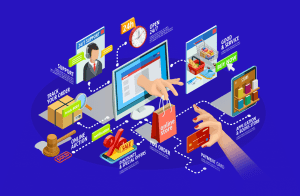A Developer's Journey in Lightspeed Ecommerce
The online retail industry has significantly changed in the last ten years, revolutionizing corporate operations and client shopping habits. The increasing need for efficient, smooth, and customized online shopping experiences has resulted in the emergence of platforms and technologies that empower retailers to meet customer demands. It is an e-commerce platform that has become popular in recent years due to its agility, scalability, and extensive range of features.
We will explore programmer’s experiences as they navigate the world of Lightspeed ecommerce. Developers have a crucial role in using the potential of this platform to build engaging online stores by overcoming obstacles and embracing new ideas. We will examine the fundamental elements programmers face, their tactics, and the changing environment of online retail.
Analyze the Online Retail Platform
It provides a comprehensive range of specialized tools designed for online retail, including inventory management, order processing, point-of-sale (POS) systems, and configurable web storefronts. The enticing qualities of its flexibility and scalability make it a preferred option for enterprises of all sizes, from tiny startups to large-scale shops.
When programmers interact with It, they enter a complex system that demands a sophisticated comprehension of several elements:
Personalization and Incorporation
Programmers often encounter the task of customizing the platform to align with certain business requirements. This entails using its APIs and SDKs to develop tailored capabilities, include third-party services, and harmonize data across disparate platforms. Programmers are essential in expanding the platform’s capabilities by developing distinctive checkout procedures, connecting with CRM software, and allowing particular product features.
Enhancing Efficiency
In the rapidly evolving realm of electronic business, swiftness is paramount. Programmers aim to enhance website performance, guaranteeing fast page loading times, effective database queries, and smooth user experiences on all devices. Caching methods, code minification, and Content Delivery Networks (CDNs) are crucial for maximum performance by shops powered by this software.
User Experience and Design
Creating an automatic and aesthetically pleasing storefront requires the joint efforts of designers and programmers. Programmers aiming to build captivating online shopping experiences must prioritize customizing themes, optimizing UI/UX components for mobile responsiveness, and guaranteeing accessibility.
Ensuring the Safety
Given the increasing worries around online data security, programmers must prioritize including strong security features. Ensuring consumer data security is vital, ranging from using SSL encryption for secure transactions to complying with industry-specific regulations like GDPR or PCI DSS.
Obstacles Encountered
Although It provides a flexible platform, programmers face several obstacles in their quest to create outstanding online retail experiences:
Restrictions and Limitations of the Platform
Although the platform is flexible, programmers may face constraints that impede the deployment of certain functionality or connectors. One must use innovative problem-solving techniques and profoundly comprehend its capabilities to balance customization and platform limits.
Interoperability and Outdated Systems
Compatibility concerns may arise when integrating it with legacy systems or third-party apps. Achieving uninterrupted data transfer across different systems while maintaining uniformity and precision requires careful strategizing and comprehensive testing.
Optimal Performance
Scalability becomes a vital consideration as an online organization expands. Programmers must proactively anticipate and resolve possible bottlenecks when traffic and transaction volumes rise. Deploying scalable systems and using performance monitoring tools is crucial for maintaining optimum performance in fluctuating workloads
Effective Approaches and Optimal Methods
Programmers employ various tactics and adhere to best practices to surmount these obstacles and fully utilize their capabilities.
Thorough Planning and Requirements Assembling
Comprehensively comprehending company needs and meticulously outlining a precise strategy before embarking on growth is crucial. Close collaboration with stakeholders facilitates the establishment of precise goals and expectations, minimizing the probability of rework or scope creep.
Utilizing the Expandability
Developers use Lightspeed’s extensibility by investigating its APIs, webhooks, and programmer tools. This allows companies to develop customized solutions, interact with other services, and automate operations, improving the platform’s functioning.
Perpetual Testing and Quality Assurance
Thorough testing at each phase of development is essential. Performing unit tests, integration tests, and performance tests aids in early detection and resolution of problems, guaranteeing a resilient and flawless online retail platform.
Cooperation and Exchange of Info
Promoting a culture of cooperation among programmers, designers, and other stakeholders nurtures creativity and fosters collaborative problem-solving. Facilitating the exchange of data, experiences, and best practices across the development team promotes increased efficiency and cultivates ongoing improvement.
Advancements Defining the Trajectory of Lightspeed ECommerce's Future
Technological advancements are causing significant changes in online retail, with many trends and innovations emerging.
Decapitated Commerce
Headless commerce, which involves separating the frontend display layers from the backend commerce operations, allows programmers to construct extremely flexible storefronts with rapid performance. Its API-centric strategy enables easy integration with headless infrastructures, providing adaptability and expandability.
Artificial Intelligence and Personalization
The presence of AI and machine learning capabilities in online retail facilitates the provision of customized purchasing experiences. AI-powered solutions improve customer engagement and increase conversions by using predictive product suggestions and dynamic pricing methods depending on customer behavior.
Viral Try-outs with Augmented Reality (AR)
AR and virtual try-on experiences are transforming the landscape of online buying by enabling buyers to see things in their surroundings or virtually test them before making a purchase. Integrating augmented reality (AR) features into shops powered by It improves customer engagement and connects the online and physical purchasing experiences.
Supply Chain Openness and Blockchain
The irreversible and transparent nature of blockchain technology enables improved visibility of supply chains and traceability of products. By incorporating blockchain technology into online retail, buyers may have more visibility into the origins of products, their validity, and the ethical sourcing procedures used.
Final Thoughts
A developer’s path in Lightspeed ecommerce is characterized by ongoing growth, creativity, and the quest to provide unmatched shopping experiences. To develop strong and expandable online shops, conquering obstacles, using innovative technology, and utilizing effective methods are crucial.
Programmers play a crucial role in the ever-changing online retail industry, leading the way in pushing change and enabling companies to succeed in the fast-paced realm of online commerce. The Lightspeed platform, combined with a programmer’s creativity, offers limitless opportunities to create amazing online retail experiences. This promises a future where innovation and a focus on consumer needs come together to transform the online buying experience.



